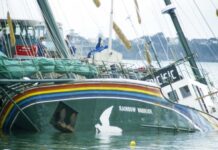Awaawaroa Eco Village residents and neighbours are relieved to get a say on plans to develop a brewery, event venue and visitor accommodation in the valley.
Auckland Council Duty Commissioner Richard Blakey has decided not to notify the public generally, but to notify the nearest neighbour, Craig Newton, and residents at the eco village, which is across the road from the planned development.
Mr Blakey says noise impacts from the development planned at 215B Awaawaroa Road could be “more than minor” for the two neighbouring properties, so he has given them a chance for input on whether resource consent should be granted.
Simon and Nicky Cairns have applied to the council for resource consent to put up seven 55 square-metre canvas glamping tents for visitors, a larger canvas house for a manager, a glasshouse, a swimming pool, a spa and meditation room, and two storage container structures.
They also plan to upgrade and extend an existing shed beside the Awaawaroa Bay wetland by 10 square metres so that it can house five events a year for up to 75 people.
The venue, which is on the seaward side of Poderi Crisci, would also be used for up to one beer tasting function a day for up to 14 people.
Mr Newton, who lives at 215c Awaawaroa Road, is pleased to be one of the two parties that will be able to make submissions opposing the development at a future hearing.
“At least we can go into a discussion about what’s appropriate for development in this area.” – Craig Newton
Mr Newton is concerned that the development is inappropriate in the peaceful, rural valley and could have a harmful impact on the environment and wildlife.
His family decided to move to Awaawaroa believing it would be “protected from the impact of tourism and loud parties”.
“Most people who live in Awaawaroa make the decision that they’re prepared to travel an extra 20 minutes to get that tranquillity,” he says.
Eco village resident Ruby Haazen says the applicants have met with some of the 37 residents at the eco village and they hope to develop a “relationship as neighbours going forward”.
Those living at the eco village have been restoring the natural environment in the valley for the past 20 years, replanting native bush and controlling pests, so that native birdlife is flourishing, says Miss Haazen.
The Department of Conservation has classified the wetland in the bay as a Site of Ecological Significance that is of “regional” importance.
Several endangered native bird species, including dotterels, banded rail, fern birds and bittern, live in the wetland and could be disturbed by functions and visitors nearby, the neighbours say.
Mr Newton and many of the 14 families at the 169-hectare eco village also fear that the development could cause more noise, as well as traffic problems on the narrow gravel road to Awaawaroa.
In his decision, Mr Blakey notes that a function facility is a “non-complying activity” in the bay and visitor accommodation for more than 10 people in the area requires special consideration.
The proposal includes 828 square metres of buildings covering the site, whereas the district plan allows for only 500 square metres of site coverage.
However, Mr Blakey states that notification of the general public is not required because the development will have no more than minor effects on the landscape, natural character and ecology of the area.
The application proposes using a 14-seat shuttle bus to take small groups to the nano-brewery, which would only be open for booked groups, rather than allowing visitors to drop in.
Up to 14 vehicle movements a day are expected at the visitor facilities, while about 20 vehicle movements are expected for events.
Mr Blakey states that the traffic generated would be low and result in no more than minor effects on local roads.
“The crash history of Awaawaroa Road does not indicate the presence of any inherent safety issues in the vicinity of the site,” he says.
The proposed development site is 300 metres from a pa, pit and terraces, but Mr Blakely notes that iwi have not raised any concerns.
The removal of about 75 square metres of native trees taller than three metres requires special consideration, because it breaches district plan rules.
However, Mr Blakey notes that proposed planting will mitigate the effects of the tree felling.
The base-camp would be about five metres from the wetland and an outdoor fire would be 10 metres from the wetland, breaching a district plan rule requiring earthworks and buildings to be at least 20 metres from a waterway.
However, Mr Blakey states that the development “will not impact on the small wetland north of the function facility”.
Effects on bird habitats to the south west of the site would be monitored by the developers, he states.
The application involves 640 square metres of earthworks on the sloping site, which exceeds the 50 square metres normally allowed.
The applicant, Mr Cairns, is seeking clarification of the reasons for notifying the two neighbours, given that the predicted night time noise levels comply with the district plan.
The company is focused on providing an “accommodation experience” and holding functions is a “secondary activity”, he says.
“As the island grows, it is natural to expect some shift towards the far end and we want to be part of a commercially sustainable community of businesses here,” says Mr Cairns. • Rose Davis







